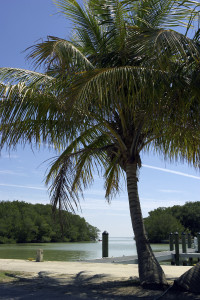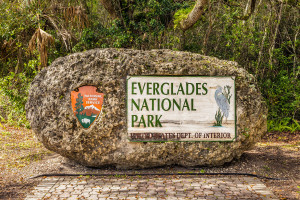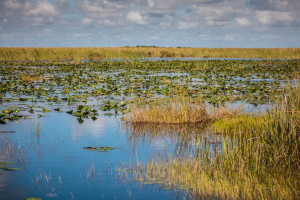 As you may have heard, the Everglades National Park won a preservation grant that will be used to restore the outside of the Flamingo Visitor Center. This visitor center has been a popular spot and attraction for visitors since the 1960s. The Center was originally built as part of the “Mission 66” program to modernize the parks for visitors.
As you may have heard, the Everglades National Park won a preservation grant that will be used to restore the outside of the Flamingo Visitor Center. This visitor center has been a popular spot and attraction for visitors since the 1960s. The Center was originally built as part of the “Mission 66” program to modernize the parks for visitors.
The Flamingo Visitor Center was built in the style of the Park Service combined with the Miami Modern style. The Miami style was developed post World War II; it reflects an international style by adds glamour, fun, and material excesses that go beyond simple modern architecture. Flamingo has bold colors, a Keystone veneer, jalousie windows and louvered screen walls.
The Park was one of 20 national parks competing for the grant. The $250,000 grant will repair the outside of the building, the landscape, and improve the visitor experience by opening a new visitor center inside.
Inside the Flamingo Visitor Center, there are educational displays, brochures, and backcountry permits. You can easily access campgrounds, a public boat ramp, a marina store, and hiking and canoeing trails near this center.
The Buttonwood Café is open in the winter. However, it is closed currently after damage from Hurricane Irma. Boat ramps are open, but fuel is unavailable and the marina store is closed. It is essential for visitors to the area to bring their own food and water.
Want to explore the Everglades in a fun and exciting way? An airboat tour is the way to go! An airboat tour with Captain Mitch’s Airboat Tours give you a glimpse of the Everglades like no other. You’ll get to see lots of animals and plants on this trip. Captain Mitch has been navigating the Everglades for decades! To book an airboat ride, click Everglades airboat rides page or call 800-368-0065.
 The Everglades is a really fun and interesting, but if you want to do more than just explore the Park on your own there’s plenty of fun tours and activities happening regularly in the Park. Summer is approaching so the activities in Park have ended for the season, but if you want to venture into the Park during the summer months, there is still plenty for you to do. Below, we wanted to share with you some activities in the Everglades:
The Everglades is a really fun and interesting, but if you want to do more than just explore the Park on your own there’s plenty of fun tours and activities happening regularly in the Park. Summer is approaching so the activities in Park have ended for the season, but if you want to venture into the Park during the summer months, there is still plenty for you to do. Below, we wanted to share with you some activities in the Everglades: The South Florida/Caribbean Network (SFCN) is a monitoring network across the National Park Service; its one of 32, actually. These networks have an inventory and monitoring program. Through this gathering of inventory and monitoring, the SFCN gives park rangers a better way to manage park resources. There are seven parks in the SFCN network including:
The South Florida/Caribbean Network (SFCN) is a monitoring network across the National Park Service; its one of 32, actually. These networks have an inventory and monitoring program. Through this gathering of inventory and monitoring, the SFCN gives park rangers a better way to manage park resources. There are seven parks in the SFCN network including:  For unfortunate reasons, we heard this name mentioned in the news back in February, but the Parkland high school and parts of the Everglades were named after the American journalist, conversationalist and women’s suffrage advocate.
For unfortunate reasons, we heard this name mentioned in the news back in February, but the Parkland high school and parts of the Everglades were named after the American journalist, conversationalist and women’s suffrage advocate. 





